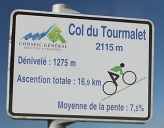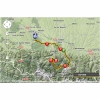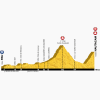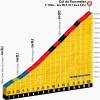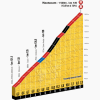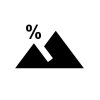The stage opens with two uncategorized climbs, a little warm-up for what is to come. Then a flat section of about 10 kilometres and then onto the first category 3 climb. This appears after 25 kilometers The Côte de Bénéjacq is 2.6 kilometers at 6.7%, and peaks at 470 meters. The maximum incline is 7.3%. Next up, after 56 kilometers, is the Côte de Loucrup. The ascent is 2 kilometres long at 7% and doesn’t deviate from this, a very regular climb.
Col du Tourmalet
After the descent, the climb of the Tourmalet actually starts, but its slight at first and the race book says the ascending doesn’t really start until Campan. This renowned col is taken from the east side and is officially 17.1 kilometres long. The first five kilometres are relatively simple. The average of the whole climb 7.3% but the last 12 kilometres rise at a 9% average. The steepest kilometre is 10%.
The Tourmalet is the most used climb in Tour history. In 1910 it appeared for the first time and since then the col has been conquered 37 times form the east and 41 times from the west. The most recent batle of note was in the 2010 Tour, where Contador and Andy Schleck went head-to-head with the latter possibly being gifted the stage win as an apology for the ‘Chaingate’ incident.
Hautacam
From the top of the Tourmalet it is still 50 kilometres to the finish, with 27 of these downhill. The climb to the ski resort of Hautacam is 13.6 kilometress long at 7.8%. The steepest part is between kilometre 8 and 9, where the road rises 11.3%.
Hautacam has only been used 4 times, most recently in the 2008 Tour- where it is unfortunately associated with the positive CERA test for Leonardo Piepoli, one of a number of the Saunier Duval team caught for abusing the substance.
Tour de France 2014 stage 18: Images and more
Click on the images to zoom
